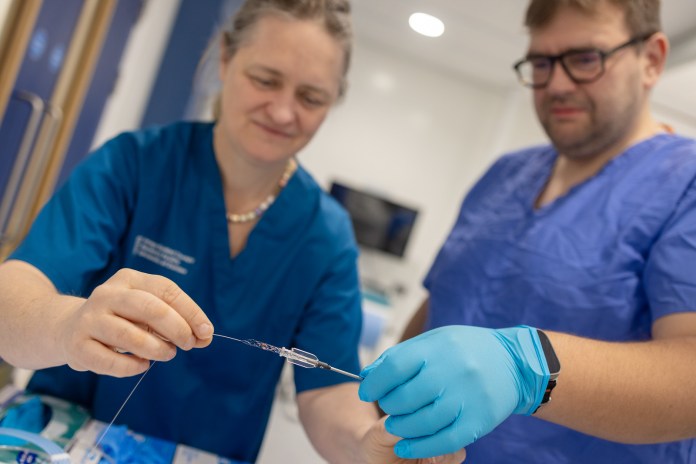Science
University of Dundee Launches Remote Stroke Treatment with Robotic Surgery

Researchers at the University of Dundee have achieved a significant breakthrough in stroke treatment by successfully performing a robotic transatlantic thrombectomy. This innovative procedure marks a new era in remote stroke care, expanding the reach of life-saving interventions across great distances.
The milestone operation was led by Professor Iris Grunwald, director of the Image Guided Therapy Research Facility (IGTRF). She previously conducted the first remote thrombectomy on a human cadaver using a robot developed by the Lithuanian MedTech company Sentante. The operation demonstrated that a blood clot could be effectively removed without the physical presence of a specialist.
The groundbreaking moment occurred when Ricardo Hanel, MD, PhD, performed the first transatlantic thrombectomy on the cadaver from the Baptist Medical Center in Jacksonville, Florida. This procedure utilized Sentante’s advanced robotic system, which relies on wires and catheters connected to a device that replicates the surgeon’s hand movements in real time at the patient’s side.
Sentante’s technology also provides authentic feedback to the surgeon’s fingertips, closely mimicking the experience of traditional manual surgery. Professor Grunwald expressed her enthusiasm, stating, “As a neurointerventionist, it is remarkable to feel the same fine control and resistance through a robotic interface as during a live procedure.” This advancement effectively bridges the gap between operator and patient, regardless of physical distance.
Each year, approximately 15 million strokes occur globally, with the UK incurring an annual cost of around £26 billion for stroke-related care, including £8.6 billion for the National Health Service (NHS) and social services. Thrombectomy is considered the most effective treatment for patients whose strokes are caused by a large blockage in the brain. Yet, less than 1% of patients worldwide currently receive this crucial treatment. In Scotland, only 212 patients underwent thrombectomy in 2024, representing a mere 2.2% of those who suffered an ischemic stroke.
Professor Grunwald emphasized the critical importance of timely treatment, noting, “By the time patients reach a specialist centre, there’s often no brain left to save. Every six-minute delay in receiving treatment equates to a 1% lesser chance of a good outcome.” She advocates for expanding expertise through specialized training to facilitate remote operations.
Dr. Hanel elaborated on the potential of this technology, stating, “Tele neurointervention will allow us to decrease the gap and further our reach to provide one of the most impactful procedures in humankind – the thrombectomy – to more people.” He also highlighted the impressive capability of operating from the US to Scotland with just a 120 millisecond delay.
The IGTRF serves as the official world training centre for doctors under the auspices of the World Federation for Interventional Stroke Treatment. The facility collaborates with Dundee’s Centre for Anatomy and Human Identification (CAHID) to offer comprehensive interventional training, medical device testing, and research opportunities.
Edvardas Satkauskas, co-founder and CEO of Sentante, praised the collaboration, stating, “The human cadaveric models at Dundee are fantastic. This is the reason we have worked with them – this is probably the only site in the world that can do this type of research.” He added that for ischemic stroke, the difference between leaving the hospital walking and experiencing a lifetime of disability can be just two to three hours.
Sentante’s robotic platform is progressing through regulatory pathways for peripheral vascular interventions, receiving Breakthrough Device Designation from the FDA for its stroke system. The collaboration with the University of Dundee represents a significant milestone, showcasing how robotics can eliminate distance as a barrier to life-saving medical care.
-

 Entertainment3 months ago
Entertainment3 months agoAnn Ming Reflects on ITV’s ‘I Fought the Law’ Drama
-

 Entertainment4 months ago
Entertainment4 months agoKate Garraway Sells £2 Million Home Amid Financial Struggles
-

 Health3 months ago
Health3 months agoKatie Price Faces New Health Concerns After Cancer Symptoms Resurface
-

 Entertainment3 months ago
Entertainment3 months agoCoronation Street’s Carl Webster Faces Trouble with New Affairs
-

 Entertainment2 weeks ago
Entertainment2 weeks agoCoronation Street Fans React as Todd Faces Heartbreaking Choice
-

 Entertainment3 months ago
Entertainment3 months agoWhere is Tinder Swindler Simon Leviev? Latest Updates Revealed
-

 World2 weeks ago
World2 weeks agoBailey Announces Heartbreaking Split from Rebecca After Reunion
-

 Entertainment4 months ago
Entertainment4 months agoMarkiplier Addresses AI Controversy During Livestream Response
-

 Science1 month ago
Science1 month agoBrian Cox Addresses Claims of Alien Probe in 3I/ATLAS Discovery
-

 Health5 months ago
Health5 months agoCarol Vorderman Reflects on Health Scare and Family Support
-

 Entertainment4 months ago
Entertainment4 months agoKim Cattrall Posts Cryptic Message After HBO’s Sequel Cancellation
-

 Entertainment3 months ago
Entertainment3 months agoOlivia Attwood Opens Up About Fallout with Former Best Friend





















